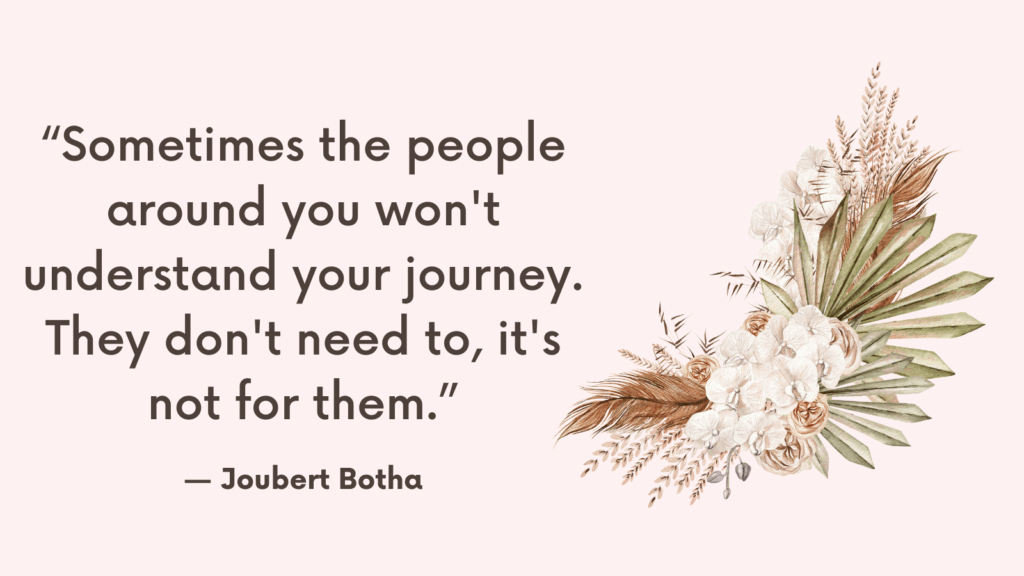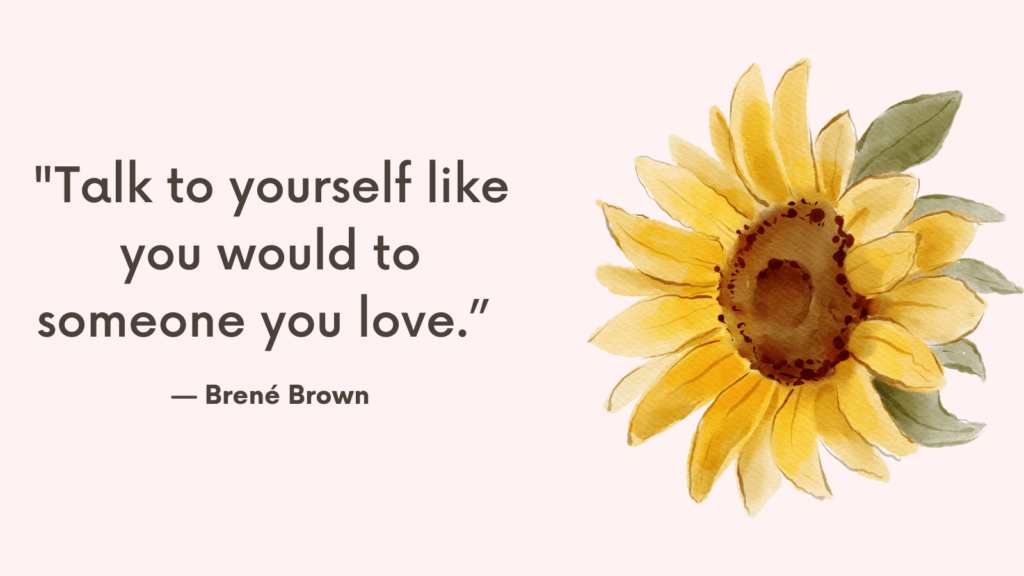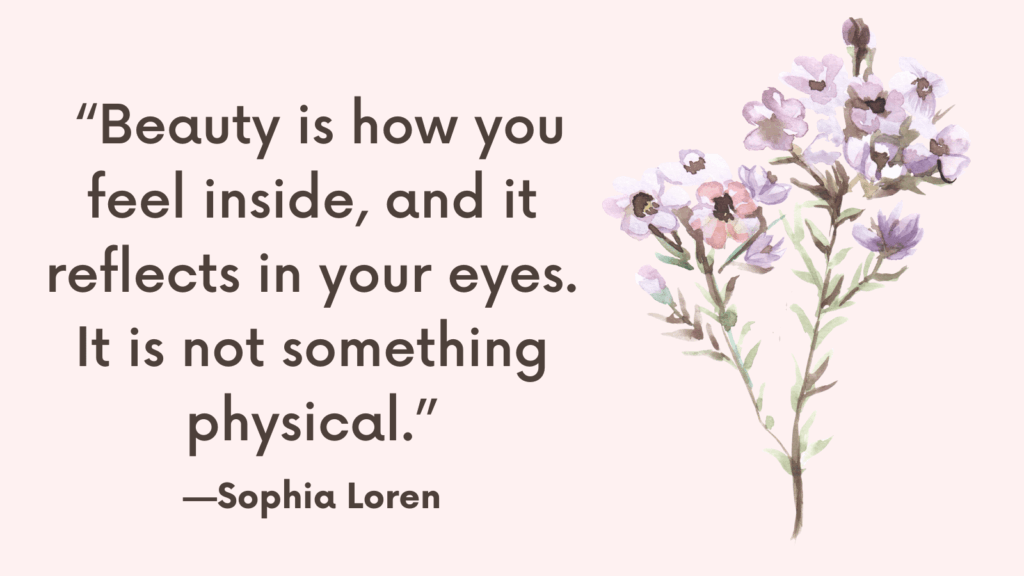Find out how to cultivate radical self-love using practical strategies.
What Is Self-Love?
Self-love is learning to practicing extending forgiveness and compassion toward ourselves, even when we’re struggling or suffering.
Self-love is about honoring our feelings and needs. This may involve putting ourselves first or setting boundaries.
What Self-Love Isn’t
Self-love is not always being happy, nor is it being perfect.
Self-love is not based on your achievements or what other people think of you.
Self-love also doesn’t involve shaming, fault-finding, or beating yourself up to become a better version of yourself.
What Is Radical Self Love?
Radical self-love is a powerful concept that encourages individuals to accept, nurture, and cherish themselves unconditionally.
It goes beyond superficial ideas of self-care and delves into a deeper level of self-acceptance, self-worth, and self-compassion.
Radical self-love promotes the idea that you are deserving of love, respect, and happiness just as you are, without needing to change or conform to external standards.
It involves embracing your flaws, honoring your boundaries, forgiving yourself for mistakes, and prioritizing your own well-being.
Ultimately, radical self-love is about cultivating a positive and loving relationship with yourself, allowing you to live authentically and fully embrace your unique qualities.
Self Love Isn’t Selfish
Many of us find it easy to care for and nurture our loved ones.
We show compassion and support them when they’re struggling or feeling low.
Yet we often struggle to extend that same treatment toward ourselves.
We mistakenly believe that self-love is selfish.
But self-love isn’t selfish.
You can’t pour from an empty cup.
When you’re struggling to love yourself, it’s difficult to give your best to others.
Related: How To Start A Self Love Journey? Top 10 Powerful Ways to Love Yourself More
Radical Self Love: Best 9 Ways To Cultivate Radical Self Love
#1. Practice The Inner Dialogue of Self-Love
People who lack self-esteem talk to themselves in a negative, self-defeating way that further undermines their self-esteem.
By changing your inner dialogue, you lay down new neural pathways in your brain that with practice become your automatic way of talking to yourself.
Affirmations for Self-Love
- I am worthy of my own love.
- I am whole and complete.
- I love myself exactly as I am.
- I am good enough just as I am.
- I am gentle, kind, and patient with myself.
- I respect and take good care of myself.
- I am the most important person in my life.
- I am proud to be me.
- I joyously forgive myself and others.
- I am now willing to see my own beauty and specialness.
- I am loved and accepted exactly as I am.
- Loving myself works miracles in my life.
- Every day I appreciate myself more and more.
- I acknowledge all I have accomplished and am proud of my achievements.
- I am a valuable person with important contributions to make.

Related: Raising low self-esteem: 18 Ways to Build High Self-Esteem

#2. Meditation: Connect With Yourself
Meditation has many emotional, physical, and spiritual benefits. It helps you manage stress and allows you to relax and find peace. This is why meditation can significantly improve chronic health issues like anxiety, chronic pain, insomnia, hypertension, and inflammatory illnesses.
When you meditate, you’re fully present and the only thing that exists at that moment. This allows for creativity and new ideas to flow freely.
The calming effect meditation has on our minds and bodies, makes it a great form of self-love.
Get comfortable, dim the lights and take a few deep breaths. If a thought comes into your mind, notice it and imagine writing it down on an imaginary sticky note to attend to later. Then shift your focus back to your breathing.
You don’t have to be in the comfort of your home to meditate, you can practice it anywhere – when you’re waiting for the subway, right before a test, when you’re waiting in line at the grocery store, etc.
Mindful Meditation
1. Take a few moments to be still and enter the world of being rather than doing.
2. Begin this exercise by focusing on your breath and feeling into your body and mind and simply allowing any thought, emotion, or physical sensation to just be.
3. You don’t need to judge, analyze, or figure things out. Spend about three minutes simply checking in with yourself.
Apps like The Mindfulness App, Headspace, Calm, and buddhify can help introduce you to mindfulness and silent meditations.
Guided Imagery Meditation
After calming yourself through breath and focus, imagine something pleasing or calming.
The key to effective visualization involves full sensory awareness. If you’re, for example, imagining a beach scene, focus on the colors you see – the blue sky with white puffy clouds, the blue water, etc. Imagine the smell of the salty air, the feel of the warm sun. Scan the scene and notice all the details that you might usually miss.
#3. Avoid Getting Overly Attached to People and Things
Before you can start working on your self-love and feel your own feelings, you need to first detach from the object of your obsession.
Many people, especially codependents, get attached to the people in their lives. By “attachment,” I don’t mean normal feelings of caring for these people or being concerned about them. Attachment is about becoming overly involved entangled.
You may find yourself:
- Worrying excessively about a problem or person (your mental energy is attached).
- Obsessing with and controlling of the people and problems in your life (your mental, physical, and emotional energy is attached).
- Becoming emotionally dependent on the people around you.
- Becoming a caretaker (rescuer, enabler) to the people around you.
When you focus all of your energy on people and problems, you won’t only have little left for yourself, but you’ll also end up feeling burdened with so much worry and responsibility.
Furthermore, worrying about people and problems doesn’t solve anything.
The Alternative: Non-Attachment
Non-attachment is not a cold, hostile withdrawal, removal of our love and concern. Nor is it a resigned, despairing acceptance of whatever life throws our way.
We emotionally, and sometimes physically release ourselves from unhealthy entanglements with someone else’s life, and from problems we cannot solve.
Non-attachment is based on the premise that everyone is responsible for himself, that it’s not our job to solve problems that aren’t ours to solve.
We give people the freedom to be who they are, to be responsible and to grow. And we give ourselves that same freedom.
The rewards: a deep sense of peace, the ability to give and receive love in self-enhancing ways, and the freedom to live our lives without excessive feelings of guilt about others.
Non-attachment is a neutral state. It helps you find a balance where you can still give and love others, but you also give and love yourself.
Related: How To Break Codependency Habits For Good? Top 13 Codependent Habits to Quit Today
How Do I Know If I’m Overly Attached?
When you can’t stop worrying about someone or something. When you feel like you have to do something for someone because you feel responsible.
When detachment seems the least likely or possible thing to do.
How Do You Make Sure You Don’t Get Overly Attached?
1. Walk Away
When you find yourself reacting to someone else’s problems, walk away from that situation emotionally and even physically.
Go for a walk, take a few deep breaths, or do something engaging that will distract you in a safe, healthy way and help restore your balance.
2. Examine What Happened
Write down your thoughts and describe your emotions in a journal or discuss it with a friend’s help to clear your thoughts and emotions.
Taking an honest look at the situation will help you take responsibility for your feelings and thoughts and empower you to take effective action.
Were you trying to control someone or some event? Are you taking responsibility for someone else? Do you need to set emotional boundaries?
3. Take Care of Yourself
Self-care will help you focus on yourself and allow others to live their lives as they choose.
Related: 45 Easy Self Care Day Ideas at Home for a Healthy Mind, Body & Soul
#4. Practice Self-Compassion
Self-compassion means having the courage to love and care about ourselves, each other, and our world.
1. Recognize and Allow Yourself to Feel Your Emotions
Mindfulness meditation helps you wake up out of distracting thoughts and bring a full, embodied attention to our moment-to-moment experience.
Many research studies have shown that mindfulness directly and positively impacts parts of the brain that correlate with self-awareness.
You become more aware of your unconscious fears and limiting beliefs that are the source of your pain and you begin to recognize how your unmet needs keep you grasping.
So instead of reacting to your unmet wants and fears, you can respond to your circumstances from a deeper emotional intelligence and inner wisdom.
Related: How To Start A Self Love Journey? Top 10 Powerful Ways to Love Yourself More
2. Investigate Your Emotions With a Gentle, Curious Attention
Bring curious and kind attention to your experience.
Rather than feeling bad about your thoughts and feelings, try to observe them and investigate them with an attitude of curiosity.
Answering the following questions may be helpful:
- What is the worst part about this? What most needs my attention?
- What is the most difficult/painful thing I am feeling?
- Are these feelings familiar, something I’ve experienced earlier in my life?
- If the most vulnerable hurting part of me could communicate, what would it say? What does this part most need from me?”
Once finished, offer yourself nurturing.
- Offer yourself loving words,
- Visualize the part of you in pain surrounded in soft, luminous healing light, or
- Imagine someone you trust offering comfort and holding you with love.
Try This
1. Take a few moments to sit quietly and relax by taking a few deep breaths.
2. Think back to the situation that triggers a moderately strong emotional reaction of hurt, anger, fear, or shame.
3. Review that situation from an observer’s point of view as if you were watching a movie.
4. When you get to the part that most activates strong emotions, freeze the frame and focus your attention on whatever is disturbing you.
5. Ask yourself, “What is happening inside me?” and notice what you’re feeling and thinking, without judging it as right or wrong, good or bad, without trying to change it or push it away. Instead of thinking, “I hate this,” just let it be. Be curious about what you’re feeling and thinking.
6. Gently investigate your emotions as if asking a loved one about what’s bothering them and curiously listening to their response.
Ask yourself,
“What emotions does this bring up (fear, anger, grief)?”
“Where are my feelings about this strongest in my body? My throat? My chest? My belly?”
“What are the feelings like? Clenched? Raw? Hot? Heavy?”
“If the most vulnerable hurting part of me could communicate, what would it say? What does this part most need from me?”
6. As you sense what is needed, try calling on the most compassionate part of you and offer yourself loving words. You may also visualize the part of you in pain surrounded by a soft, luminous healing light, or imagine someone you trust offering comfort.

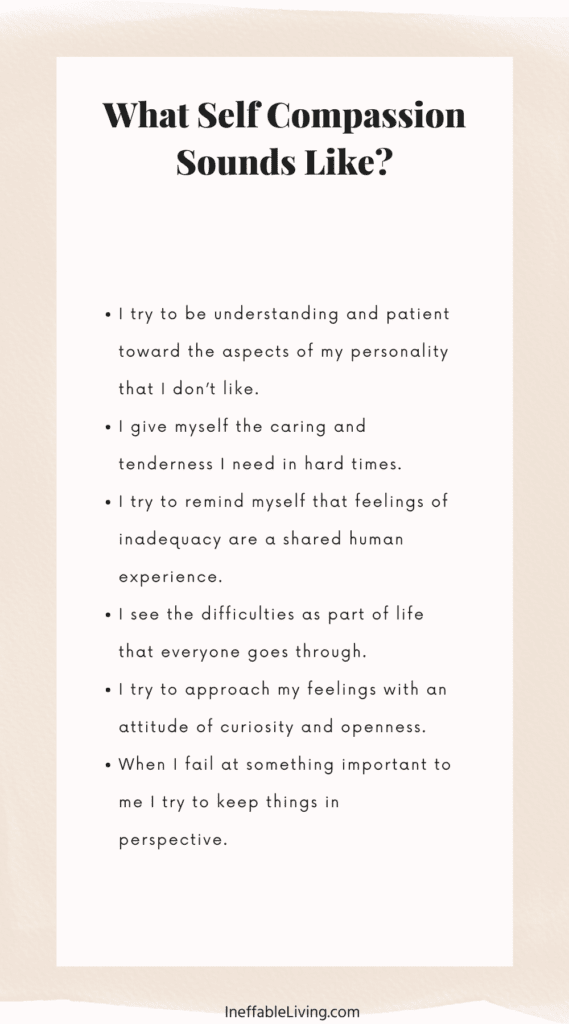
#5. Start Journaling
Journaling is perhaps the simplest and cheapest form of therapy. It can provide a reminder and feedback when times get tough.
It can also help you learn more about yourself—your perceptions, judgments, and assumptions, provide an outlet for pent-up emotions and frustrations.
Writing for twenty minutes daily has been shown to improve mood, decrease stress and anxiety, and even improve the immune system as it helps release negative emotions and stress.
Journaling Prompts for Self-Love
- What is your favorite thing about your personality?
- What do you think your biggest weakness is? What can you do to improve?
- How would your best friend describe you?
- What are you most grateful for in your life?
- Is there anything that happened a long time ago that you’re still ruminating about?
- What is the thing that you need to forgive yourself for?
- What are the things that you need to stop doing and that are making you unhappy?
- What is your favorite thing to do to treat yourself?
- When do you feel most happy?
- What would you change in your life if you were more confident?
#6. Challenge Your Negative Thoughts
When negative thoughts crop up, practice challenging their validity before you redirect your attention to positive thoughts.
Make sure you don’t suppress your negative thoughts by ignoring them or fighting them. Doing that will only intensify them.
Put Your Thoughts On The Witness Stand
Identify your destructive thoughts patterns and start to challenge them with questions such as:
- Do I have experiences that would contradict my thoughts in any way?
- What evidence do I have that what I believe is actually true?
- Am I falling into a thinking trap (e.g., catastrophizing or all-or-nothing treatment)?
- What would I tell a friend if he/she had the same thought?
- Am I confusing a thought with a fact?
- Am I basing my conclusion mostly on my feelings or on the true evidence?
Related: Top 10 Common Examples of Cognitive Distortions – How To Challenge Them (+Worksheets PDF)
Practice Positive Thinking
Choose empowering thoughts (mantras and affirmations) to repeat after addressing and releasing your negative thoughts.
Redirecting your attention to positive, empowering thoughts will automatically elevate your energy and your feelings.
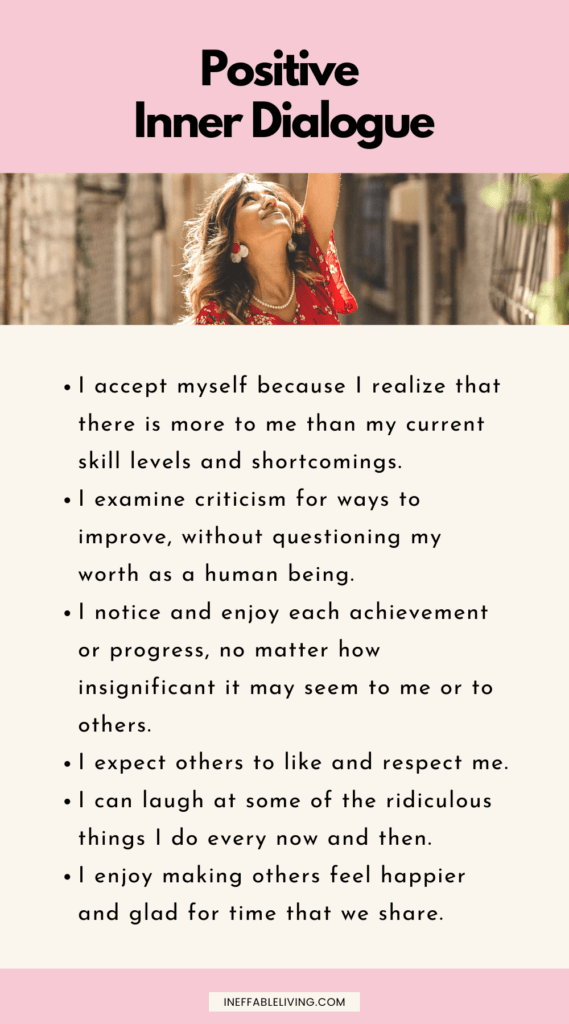
#7. Set Healthy Emotional Boundaries
Begin defining your own needs and desires and communicating them by setting boundaries —limits and rules for your relationship with other people.
Emotional boundaries define what you tolerate and don’t tolerate from other people.
It also helps acknowledge the emotional separation between yourself and other people, separating you from other people’s actions and responses.
Do you need to set boundaries?
- Do you take responsibility for other people’s feelings and needs?
- Do you prioritize other people’s feelings and needs while neglecting your own?
- Do you become upset because the other person is upset?
Before setting boundaries, you need to first define your responsibilities and rights.
You are not responsible for other people’s life, moods, feelings, or distorted perceptions of you. Neither are people responsible for yours.
How to Set Boundaries?
Step One: Define Your Needs
If you find it difficult to figure out what you want, try reversing the question and ask yourself what treatment you don’t want.
What makes you feel diminished, belittled, or powerless?
What is and isn’t okay for you?
Remember you have the right to be treated with respect and to refuse unfair treatment or criticism.
Step Two: Use Position Statements to Communicate Your Boundaries
A boundary is meaningless unless it is communicated to other people.
Use clear, direct, nondefensive expressions to communicate your boundaries. Position statements begin with words like:
- I need you to . . .
- It’s not okay that you . . .
- I am no longer willing to . . .
- It is no longer acceptable for you to . . .
Step Three: Plan Your Responses
In a perfect world, you’d state your needs and the other person would say something like, “I didn’t realize that was bothering you. Of course I’ll change!”
But real life is not as simple as that. Your boundary-setting will come as a shock to other people and they might push back.
That’s why you need to be prepared for what other people will say and to practice the responses you’ll give, without being drawn into arguments and explanations.
You might say something like, “It bothered me a lot. I just never had the courage to say anything about it before. . .”
Step Four: Decide on Reasonable Consequences
You can’t control other people’s reaction, but you can control yours.
To reinforce your boundaries and demonstrate your seriousness both to yourself and the other person, state the consequences – the action you’ll take if they don’t respect your boundaries.
Examples of consequences may include:
- Leaving the room
- Asking the other person to leave
- Hanging up the phone
- Reducing contact with them
Related: How To Set Boundaries With Narcissistic Parents?
#8. Practice Radical Acceptance
You increase your ability to tolerate distress and reduce your suffering when you begin to change your attitude toward pain.
When a person is in pain, their first reaction is to get upset or frustrated about their pain, or even blame someone for causing the pain.
Their frustration and blame would only increase the pain and lead to suffering.
What’s the difference between pain and suffering?
1. Pain Has A Purpose
Just as physical pain is designed to notify us when something is wrong, so is emotional pain.
While you hate being in pain, if you didn’t have pain, chances are you would be dead by now. Physical pain sends a powerful signal that something is wrong, nudging you to take action of some kind before your situation gets worse, potentially leading to premature death.
Emotions work the same way. They signal you to do something about your current situation. Perhaps, you need to quit your job, let go of toxic relationships, or change a disempowering story that creates suffering in your life.
2. Suffering Is A Choice
When you don’t look at the underlying causes for your emotions by avoiding it or ignoring it, and choose instead to focus on the unpleasant way it makes you feel, you create suffering.
You get caught up in negativity and complaining at the unfairness of our situation, when you focus on the discomfort, rather than noticing the message behind it.
Unfortunately, this can only prolong the pain—and create suffering.
3. Accepting The Pain While Avoid Suffering (In A Healthy Way)
The first reaction people have when they feel discomfort, is to silence their painful emotions using food, alcohol, drugs, sex, or even work.
However, the only way to stop suffering is to actually choose to stay open to our pain and carefully listen to what it is trying to tell you.
You don’t have to let your pain make you angry or frustrated. You can learn to observe your pain and its feedback while realizing that emotions are fleeting and temporary.
Related: Overcome Suffering In Your Own Way: 4 Keys To Relieve Suffering
#9. Healthy Body, Healthy Mind
There is a strong relationship between our body and our mind. When you don’t take adequate care of your body, your mental health will begin to deteriorate.
You get out of shape. You might experience chronic pain and be more prone to getting sick. As a result, you start experiencing a lowered sense of self-worth.
By not taking care of your body, you are directly telling your mind that you don’t feel worthy of the time and attention and you prioritize other things. This damages your self-esteem and confidence.
Our bodies can also directly impact our mental health. An unhealthy body generally has imbalanced hormones, which affect the way we perform basic tasks and increases our stress.
Balance your health once again by doing the following:
1. Take better care of your diet
Your gut health is responsible for nearly your whole body including your hormones and organ function.
Make sure your diet is rich in color, includes adequate proteins, fatty acids, and other important nutrients. Steer away from processed food and artificial sweeteners.
A Brain-Friendly Diet
* Consume most of your calories from minimally processed plant foods.
* Reduce the size of meat servings, especially red and processed meat (for example, corned beef, bacon, ham, salami, hot dogs).
* Keep blood sugar steady by eating a high-quality protein breakfast (for example, eggs or yogurt) and not skipping meals, and minimize sugar-sweetened beverages and snacks.
2. Exercise more frequently
This isn’t just about going to the gym. Exercise should be a lifestyle.
Small choices such as going for a walk, taking the stairs instead of the elevator, walking your pet, or volunteering to walk the neighbor’s pet, etc, can add up and improve your health.
3. Receiving adequate rest
Getting consistent, high-quality sleep has a significant role in improving your well-being. It reduces your stress levels and helps you function effectively throughout the day. Make sure you get 7 to 8 hours of sleep every night.
Go to bed earlier and set a night routine that helps you relax, such as a light dinner, reading fiction, taking a warm bath, drinking chamomile tea, lowering your house light an hour before bedtime, turning off screens, etc.
Pro Tip: Fall asleep faster with Amber light. SOMNILIGHT offers a wide range of products that blocks blue light and help you fall asleep up to an hour faster. Use this link to receive a coupon code for 10% off any purchase. (Free U.S. shipping and 60-day money back guarantee.)
Related: 45 Easy Self Care Day Ideas at Home for a Healthy Mind, Body & Soul

References
- The importance of self-love and how to cultivate it (medicalnewstoday.com)
- Self-Love and What It Means | Brain & Behavior Research Foundation (bbrfoundation.org)
- Learn How to Self-love | Psychological Health Care
- The science of self-love: the evidence-based benefits of loving yourself (nesslabs.com)
- The Scientific Benefits of Self-Compassion – The Center for Compassion and Altruism Research and Education (stanford.edu)
- Self-esteem in a broad-spectrum approach for mental health promotion | Health Education Research | Oxford Academic (oup.com)
- Why self-compassion – not self-esteem – leads to success – BBC Worklife
- Loving yourself more than your neighbor: ERPs reveal online effects of a self-positivity bias – PMC (nih.gov)
- Self-Love or Other-Love? Explicit Other-Preference but Implicit Self-Preference | PLOS ONE
- The Role of Self-Compassion in Development: A Healthier Way to Relate to Oneself – PMC (nih.gov)
